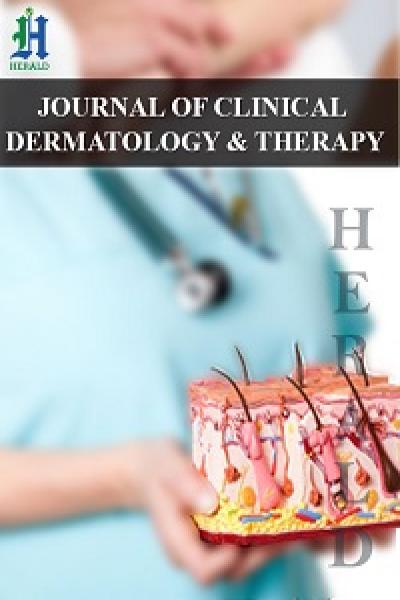
Severe Onychomycosis with Dermatophytoma Successfully Treated with Long Pulsed Nd: Yag Laser
*Corresponding Author(s):
Maria Claudia Carvas Passarelli TiricoDepartment Of Dermatology, Hospital Das Clínicas, Medical School, University Of São Paulo, São Paulo, SP, Brazil
Tel:+55 1141750606,
Email:dramariaclaudiatirico@gmail.com
Onychomycosis is a highly prevalent disease, with an incidence of 10% in general population. Rates are even higher in the elderly, reaching 50% in individuals over 70 years. In addition to the obvious aesthetic impairment, functional debility also occurs as patients often experience pain, difficulty putting on shoes and walking, fungal spread to the skin and risk of acute paronychia. Furthermore, it is a gateway for bacteria and can lead to erysipela [1].
Conventional treatment includes 2 modalities, topical and oral. Topical treatment is not related to the development of adverse effects and is easy to apply, however it has very low cure rates. Systemic treatment, on the other hand, has a more satisfactory clinical cure rate, but is related to hepatic, renal and cardiological adverse effects as well as drug interactions with other treatments. Clinical features such as subungual hyperkeratosis greater than 2 mm and the presence of dermatophytoma are related to a worse prognosis and generally require the association of some form of debridement [2,3].
Facing the frustration of topical approach and the fear of possible side effects with the oral medication, new treatment alternatives are being investigated. In 2012, the FDA recognized laser technology as a method of improving the appearance of the nail temporarily. Since then, different wavelengths have been experimented over onychomycosis [4].
We followed 8 cases with microbiological confirmation of severe onychomycosis presenting with dermatophytoma for 12 months at the Dermatology Outpatient Clinic of the Hospital das Clínicas of São Paulo. Patients were 33 to 63 years old, had not yet undergone any treatment for the disease in question, did not present immunosuppression and did not have peripheral vascular disease. Informed consent was obtained from all patients at enrollment. Nails were photographed and classified according to the Onychomycosis Severity Index before treatment and after 1 month, 3 months, 6 months, and 12 months. Patients received 4 to 7 treatment sessions every 2 weeks with the long-pulse 1064 nm Nd:Yag laser at 6mm spot size, 40ms and 70-80J/cm2 (Etherea®, Vydence, USA). The procedure was well tolerated and there were no complications. A decrease in the OSI score was noted over time until index zero at 12 months, configuring clinical cure (Figures 1&2).
 Figure 1: Sample patient LAB (from left to right: before, 6 months 12 months).
Figure 1: Sample patient LAB (from left to right: before, 6 months 12 months).
 Figure 2: Sample patient LOC (from left to right: before, 1 month, 3 months, 12 months).
Figure 2: Sample patient LOC (from left to right: before, 1 month, 3 months, 12 months).
Dermatophytoma represents a cluster of fungi that forms a biofilm, making it difficult for systemic medications to penetrate. These are difficult cases to manage, and often even oral treatment fails. Many authors recommend the use of physical or chemical abrasive measures to break down this phytoma and obtain more satisfactory results [5]. The 1064 nm long pulsed laser generates intense heat below the nail plate, which may break the biofilm of this dermatophyte and have a direct fungicidal effect.
Robust scientific evidence is still needed to establish a laser guideline for the treatment of onychomycosis however it can already be considered an auxiliary therapy, or it can be used as a monotherapy whenever systemic medication is not an option. Further investigation should be conducted to enlighten the mechanisms of action of laser radiation over the dermatophytoma and the fungal structure. With this study, we were able to demonstrate that the Nd: Yag laser can successfully treat dermatophytoma and cure severe onychomycosis as a monotherapy.
Conflict of Interest
None
References
- Elewski BE (2000) Onychomycosis. Treatment, quality of life, and economic issues. Am J Clin Dermatol 1: 19-26.
- Gupta AK, Mays RR, Versteeg SG, Piraccini BM, Takwale A, et al. (2019) Global perspectives for the management of onychomycosis. Int J Dermatol. 58: 1118-1129.
- Gupta AK, Wang T, Cooper EA (2022) Dermatophytomas: Clinical Overview and Treatment. J Fungi (Basel) 8: 742.
- Ma W, Si C, Kasyanju Carrero LM, Liu HF, Yin XF, et al. (2019) Laser treatment for onychomycosis: A systematic review and meta-analysis. Medicine (Baltimore) 98: 17948.
- Burkhart CN, Burkhart CG, Gupta AK (2002) Dermatophytoma: Recalcitrance to treatment because of existence of fungal biofilm. J Am Acad Dermatol 47: 629-631.
Citation: Tirico MCCP, Torezan LAR (2024) Severe Onychomycosis with Dermatophytoma Successfully Treated with Long Pulsed Nd: Yag Laser. J Clin Dermatol Ther 10: 0139.
Copyright: © 2024 Maria Claudia Carvas Passarelli Tirico, et al. This is an open-access article distributed under the terms of the Creative Commons Attribution License, which permits unrestricted use, distribution, and reproduction in any medium, provided the original author and source are credited.

